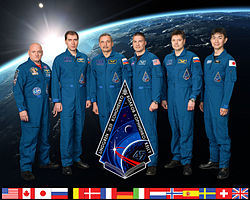ISS expedition 45
| Mission emblem | |||
|---|---|---|---|

|
|||
| Mission dates | |||
| Mission: | ISS expedition 45 | ||
| Crew: | 6th | ||
| Rescue ships: | Soyuz TMA-17M , Soyuz TMA-18M | ||
| Space station: | International space station | ||
| Start: | September 11, 2015, 21:29 UTC | ||
| Started by: | Decoupling from Soyuz TMA-16M | ||
| The End: | December 11, 2015, 09:49 UTC | ||
| Ended by: | Decoupling from Soyuz TMA-17M | ||
| Duration: | 90 d, 12 h, 20 min | ||
| Number of EVAs : | 2 | ||
| Total length of the EVAs: | 15h 4min | ||
| Team photo | |||
 v. l. To the right: Scott Kelly, Sergei Wolkow, Michail Kornijenko, Kjell Lindgren, Oleg Kononenko and Kimiya Yui
|
|||
| navigation | |||
|
|||
ISS Expedition 45 is the mission name for the 45th long-term crew of the International Space Station (ISS). The mission began with the decoupling of the Soyuz TMA-16M spacecraft from the ISS on September 11, 2015. The end was marked by the decoupling of the Soyuz TMA-17M on December 11, 2015.
team
Taken over from ISS Expedition 44 :
- Scott Joseph Kelly (4th Spaceflight), Commander, ( USA / NASA ) ( Soyuz TMA-16M / Soyuz TMA-18M )
- Michail Borissowitsch Kornijenko (2nd space flight), flight engineer, ( Russia / Roskosmos ) (Soyuz TMA-16M / Soyuz TMA-18M)
- Oleg Dmitrijewitsch Kononenko (3rd space flight), flight engineer, (Russia / Roskosmos) ( Soyuz TMA-17M )
- Kimiya Yui (1st Spaceflight), Flight Engineer, ( Japan / JAXA ) (Soyuz TMA-17M)
- Kjell Lindgren (1st Spaceflight), Flight Engineer, (USA / NASA) (Soyuz TMA-17M)
Additionally from December 4th 2015:
- Sergei Alexandrowitsch Wolkow (3rd space flight), flight engineer, (Russia / Roscosmos) ( Soyuz TMA-18M )
Mission description
For the first time on the ISS, crew members with Michail Kornijenko and Scott Kelly were extended to one year in order to better study the effects of long-term weightlessness with regard to a manned flight to Mars . Sergei Volkov took the ESA astronaut Andreas Mogensen and the Kazakh cosmonaut Aidyn Aimbetow on a short-term mission to the ISS in his Soyuz spaceship in the two vacant spaces .
Freight traffic
Due to the clarification of an error message from the gripper arm of the space station, Kimiya Yui, with the support of Kjell Lindgren, set HTV-5 back into orbit on September 28, 2015 at 16:53 UTC with an earth orbit delay . The unmanned transporter filled with rubbish was specifically brought to burn up in the earth's atmosphere by the flight controllers on the following day.
The unmanned Russian freighter Progress M-29M was launched from the Baikonur Cosmodrome on October 1, 2015 at 16:49:40 UTC and easily reached the intended orbit. Progress M-29M transported more than 3 tons of food, fuel and other equipment for the crew of the space station. The transporter coupled by on Andockknoten Zvezda on. After only a six-hour approach, the transporter docked at the International Space Station on October 1, 2015 at 22:53 UTC.
On December 6, 2015 at 21:44:57 UTC, a Cygnus spacecraft (called "SS Deke Slayton II") with an Atlas V rocket took off from Launch Complex 41 at Cape Canaveral Air Force Station in Florida. Cygnus carried more than 3,175 kg of scientific experiments, equipment and other hardware to the space station to support dozens of the approximately 250 experiments and research carried out on Expeditions 45 and 46 . For the first time, an Atlas V rocket was used to launch a Cygnus freighter, which can transport a larger payload and support the Orbital ATK transport service more flexibly. It was Orbital ATK's fourth mission under NASA's Commercial Resupply Services program . Cygnus reached the space station on December 9, 2015. Kjell Lindgren and Scott Kelly used the station's gripper, Canadarm2 , to capture the freighter and attach it to the ISS. It is the first transport spaceship to anchor at the Earth-facing docking point of the Unity module . After a one-month stay, Cygnus is said to be loaded with more than 1,360 kg of waste and later deliberately brought down.
External works
Commander Scott Kelly and flight engineer Kjell Lindgren completed their first spacecraft on October 28, 2015 (7h 16m). The focus of this EVA was on various works to improve the space station. This also included attaching a heat protection cover to the alpha magnet spectrometer . This state-of-the-art particle detector for investigating cosmic radiation was installed on the space station in 2011.
On November 6th, 2015 Kelly and Lindgren left the space station through the Quest airlock for a second EVA (7h 48m). The two astronauts tried to restore the original configuration in the ammonia cooling circuit in the port side of the ITS lattice structure. During an outboard operation in November 2012, attempts were made to locate a leak in the circuit, but the leak has now been located in a different part.
See also
Web links
- ISS-Expedition 45 at Spacefacts.de
- ISS-Expedition 45 on the website of NASA (English)
Individual evidence
- ↑ Планируемые полёты. astronaut.ru, September 14, 2013, accessed September 17, 2013 (Russian).
